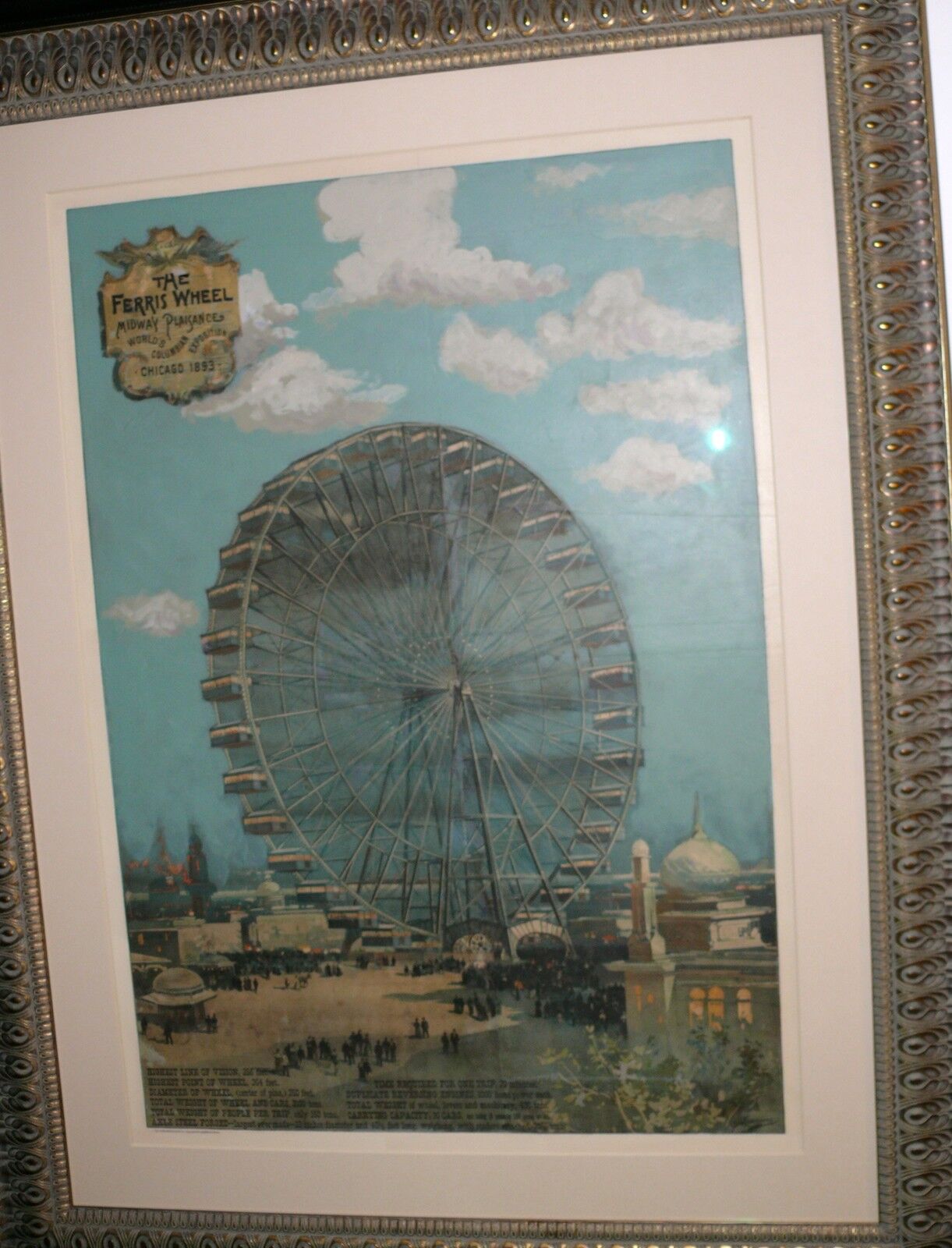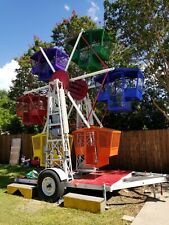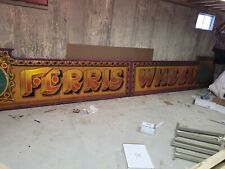FERRIS WHEEL MIDWAY PLAISANCE WORLD'S COLUMBIAN EXPOSITION CHICAGO 1893 POSTER

When you click on links to various merchants on this site and make a purchase, this can result in this site earning a commission. Affiliate programs and affiliations include, but are not limited to, the eBay Partner Network.
FERRIS WHEEL MIDWAY PLAISANCE WORLD'S COLUMBIAN EXPOSITION CHICAGO 1893 POSTER:
$19000.00
EXCEEDINGLY RARE POSTER ON LINEN BACK PROFESSIONALLY RESTOREDMUSEUM FRAMED MUSEUM GLASS ARCHIVAL PROTECTED.1893 PSTER 41 X 28 WITH FRAME ADD 10 INCHES EACH DIMENSION.SEE RESTORATION VIDEO AT BOTTOM OF PAGE
World's Columbian ExpositionFrom Wikipedia, the free encyclopediaAttractions
The World's Columbian Exposition was the first world's fair with anarea for amusementsthat was strictly separated from the exhibition halls. This area, developed by a
young music promoter,Sol Bloom, concentrated onMidway Plaisanceand introduced the term "midway" to American English to describe the area of a carnival or fair
wheresideshowsare located.
The original Ferris WheelIt included carnival rides, among them the originalFerris Wheel, built byGeorge Ferris. This wheel was 264 feet (80m) high and had 36
cars, each of which could accommodate 60 people. The importance of the Columbian Exposition is highlighted by the use of "Rueda de
Chicago" (Chicago Wheel) in many Latin American countries such as Costa Rica and Chile in reference to the Ferris
Wheel.[citation needed]
Eadweard Muybridgegave a series of lectures on the Science of Animal Locomotion in the Zoopraxographical Hall, built specially for that purpose on Midway Plaisance. He used hiszoopraxiscopeto show hismoving picturesto a paying public. The hall was the first commercial movie theater.[18]
The "Street in Cairo" included the popular dancer known asLittle Egypt.[19]She introduced America to the suggestive version of thebelly danceknown as the "hootchy-kootchy", to a tune said to be improvised by Sol Bloom (and now more commonly associated with snake charmers).[20]Bloom did not copyright the song, putting it straight into thepublic domain.
For the Sufjan Stevens song, seeIllinois (album).TheStatue of the Republicoverlooks the World's Columbian Exposition, Chicago, 1893Thomas Moran-Chicago World's Fair-Brooklyn MuseumTheWorld's Columbian Exposition(the official shortened name for theWorld's Fair: Columbian Exposition,[1]also known asThe Chicago World's Fair) was aWorld's Fairheld inChicagoin 1893 to celebrate the 400th anniversary ofChristopher Columbus's arrival in theNew Worldin 1492. Chicago bestedNew York City;Washington, D.C.; andSt. Louisfor the honor of hosting the fair. The fair had a profound effect on architecture, the arts, Chicago's self-image, and American industrial optimism. TheChicago Columbian Expositionwas, in large part, designed byDaniel BurnhamandFrederick Law Olmsted. It was the prototype of what Burnham and his colleagues thought a city should be. It was designed to followBeaux Artsprinciples of design, namely Frenchneoclassical architectureprinciples based on symmetry, balance, and splendor.
The exposition covered more than 600 acres (2.4km2), featuring nearly 200 new (but purposely temporary) buildings of predominately neoclassical architecture,canalsandlagoons, and people and cultures from around the world. More than 27 million people attended the exposition during its six-month run. Its scale and grandeur far exceeded the otherworld fairs, and it became a symbol of the emergingAmerican Exceptionalism, much in the same way thatthe Great Exhibitionbecame a symbol of theVictorian eraUnited Kingdom.
Dedication ceremonies for the fair were held on October 21, 1892, but the fairgrounds were not actually opened to the public until May 1, 1893. The fair continued until October 30, 1893. In addition to recognizing the 400th anniversary of the discovery of the New World by Europeans, the fair also served to show the world that Chicago had risen from the ashes of theGreat Chicago Fire. This had destroyed much of the city in 1871. On October 9, 1893, the day designated as Chicago Day, the fair set a record for outdoor event attendance, drawing 716,881 persons to the fair.
Many prominent civic, professional, and commercial leaders from around the United States participated in the financing, coordination, and management of the Fair, including Chicago shoe tycoon Charles Schwab, Chicago railroad and manufacturing magnateJohn Whitfield Bunn, and Connecticut banking, insurance, and iron products magnateMilo Barnum Richardson, among many others.[2]
The exposition was such a major event in Chicago that one of the stars on themunicipal Flaghonors it.[3][4]
Contents[hide]- 1Planning and organization
- 2Description
- 2.1White City
- 2.1.1Surviving structures
- 2.2The White City and The City Beautiful Movement
- 2.1White City
- 3Electricity at the fair
- 4Attractions
- 5Black musicians at the fair
- 6Other music at the fair
- 7Non musical attractions
- 8Notable firsts at the fair
- 9Later years
- 10Gallery
- 11See also
- 12Notes
- 13References
- 14Further reading
- 15External links
The fair opened in May and ran through October 30, 1893. Forty-six nations participated in the fair (it was the first world's fair to have national pavilions[7]), constructing exhibits and pavilions and naming national "delegates" (for example, Haiti selectedFrederick Douglassto be its delegate).[8]The Exposition drew nearly 26 million visitors. It left a remembered vision that inspired theEmerald CityofL. Frank Baum'sLand of OzandWalt Disney's theme parks. Disney's father Elias was a construction worker on some of the buildings at the fair.[9]
The exposition was located inJackson Parkand on theMidway Plaisanceon 630 acres (2.5km2) in the neighborhoods of South Shore, Jackson Park Highlands,Hyde ParkandWoodlawn.Charles H. Wackerwas the Director of the Fair. The layout of the fairgrounds was created by Frederick Law Olmsted, and the Beaux-Arts architecture of the buildings was under the direction of Daniel Burnham, Director of Works for the fair. Renowned local architectHenry Ives Cobbdesigned several buildings for the exposition. The Director of the American Academy in Rome,Francis David Millet, directed the painted mural decorations. Indeed, it was a coming-of-age for the arts and architecture of the "American Renaissance", and it showcased the at the fair
The International Exposition was held in a building which was devoted to electrical exhibits.General ElectricCompany (backed byThomas EdisonandJ.P. Morgan) had proposed to power the electric exhibits withdirect currentoriginally at the cost of US$1.8 million. After this was initially rejected as exorbitant, General Electric re-offer their costs at $554,000. However,Westinghouse, armed withNikola Tesla'salternating currentsystem, proposed to illuminate the Columbian Exposition in Chicago for $399,000, and Westinghouse won the offer.[15]It was a historical moment and the beginning of a revolution, as Nikola Tesla andGeorge Westinghouseintroduced the public to alternating-currentelectricalpower by illuminating the exposition. All the exhibits were from commercial enterprises. Thomas Edison, Brush,Western Electric, and Westinghouse had exhibits. The public observed firsthand the qualities and abilities of alternating current power.
World's FairTeslaalternating currentpresentationTesla's high-frequencyhigh-voltagelighting produced more efficient light with quantitatively less heat. Atwo-phaseinductionmotorwas driven by current from the maingeneratorsto power the system. Edison tried to prevent the use of his light bulbs in Tesla's works. General Electric banned the use of Edison's lamps in Westinghouse's plan in retaliation for losing the offer. Westinghouse's company quickly designed adouble-stopper lightbulb(sidestepping Edison's patents) and was able to light the fair. The Westinghouse lightbulb was invented byReginald Fessenden, later to be the first person to transmit voice by radio. Fessenden replaced Edison's delicate platinum lead-in wires with an iron-nickel alloy, thus greatly reducing the cost and increasing the life of the lamp.[16]
The Westinghouse Company displayed severalpolyphase systems. The exhibits included a switchboard, polyphase generators, step-uptransformers, transmission line, step-down transformers, commercial size induction motors and synchronous motors, and rotary direct current converters (including an operational railway motor). The working scaled system allowed the public a view of a system of polyphase power which could be transmitted over long distances, and be utilized, including the supply of direct current. Meters and other auxiliary devices were also present.
Tesla displayed his phosphorescent lighting, powered without wires by high-frequency fields, and employed a similar process, using high-voltage, high-frequency alternating current to shoot lightning from his fingertips.[citation needed]Tesla displayed the first practical phosphorescent lamps (a precursor tofluorescent lamps). Tesla's lighting inventions exposed to high-frequency currents would bring the gases to incandescence.[citation needed]
Also at the Fair, theChicago Athletic Association Football teamplayed one of the very firstnight footballgames againstWest Point(the earliest being on September 28, 1892 betweenMansfield State NormalandWyoming Seminary). Chicago won the game 14-0. The game lasted only 40 minutes, compared to the normal 90 minutes.[17]
[edit]Black musicians at the fairThe fair featured a number of important and soon to be important figures in African-American music including and provided an early exposure to white America of various strains of black music;
- Scott Joplin~ The young pianist and cornet player led a small band playing an early version ofragtime. Although not an official part of the expo they are believed to have played gigs on the outskirts of the fair.[21]Scott Joplin's performance at the exposition introducedragtimeto new audiences.[22]The exposition attracted attention to the Chicago ragtime scene, led by patriarchimprove this articleby adding citations toreliable sources. Unsourced material may bechallengedandremoved.(March 2011)
- Phosphorescent lamps (a precursor tofluorescent lamps)[citation needed]
- F.W. Rueckheim introduced a confection of popcorn, peanuts and molasses, it was given the nameCracker Jackin 1896.
- Congress of Mathematicians,[40]precursor toInternational Congress of Mathematicians
- Elongated coins
- Frederick Jackson Turnerlectured on hisFrontier thesis.
- Ferris Wheel
- First fully electrical kitchen including an automatic dishwasher
- John T. Shayne & Company, the local Chicago furrier helped America gain respect on the world stage of manufacturing
- Juicy Fruitgum[3]
- Quaker Oats[3]
- Cream of Wheat
- Shredded Wheat[3]
- Thehamburgerwas introduced to the United States[citation needed]
- Milton Hersheybought a European exhibitor's chocolate manufacturing equipment and added chocolate products to his caramel manufacturing business.
- TheUnited States Post Office Departmentproduced its first picturepostcardsandCommemorative stamp set.
- United States Mintoffered its first commemorative coins: aquarterandhalf dollar.
- Contribution to Chicago's nickname, the "Windy City". Some argue thatCharles Anderson Danaof theNew York Suncoined the term related to the hype of the city's promoters. Other evidence, however, suggests the term was used as early as 1881 in relation to either Chicago's "windbag" politicians or to its weather.
- The poet and humoristBenjamin Franklin King, Jr.first performed at the exposition.
- The "clasp locker," a clumsy slide fastener and forerunner to thezipperwas demonstrated byWhitcomb L. Judson.
- To hasten the painting process during construction of the fair in 1892,Francis Davis Milletinventsspray painting.
- Pabst Blue Ribbon
- Spectacle Reef Light
- Exposition Universelle (1900)
- Pan-American Exposition
- St. John Cantius in Chicago, whose main altar, as well as its matching two side altars, reputedly originate from the 1893 Columbian Exposition
- Herman Webster Mudgett
- World's Largest Cedar Bucket
- 1893: A World's Fair Mystery, an interactive fiction that recreates the Exposition in detail
- Against the Day, a novel byThomas Pynchon
- Expo: Magic of the White City, a documentary film about the exposition
- Jimmy Corrigan, the Smartest Kid on Earth, a graphic novel byChris Ware
- The Devil in the White City, non-fiction book about the Exposition
- Wonder of the Worlds, an adventure novel bySesh Heri
- Benjamin W. Kilburn, stereoscopic view concession and subsequent views
FERRIS WHEEL MIDWAY PLAISANCE WORLD'S COLUMBIAN EXPOSITION CHICAGO 1893 POSTER:
$19000.00

Related Items:$25000.00
FERRIS WHEEL MIDWAY PLAISANCE WORLD'S COLUMBIAN EXPOSITION CHICAGO 1893 POSTER
$19000.00
FERRIS WHEEL SIGN/LIGHT RARE ORIGINAL PAINTING VERY NICE 1950S EARLY 60S
$11000.00







